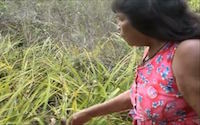Trumai is an isolate language, that is, its genetic affiliations are unknown. Possibly the other languages that were related to Trumai already disappeared without any kind of documentation or record, which then would make Trumai the only existent representative of an entire linguistic family.
Greenberg (1987) proposes that Trumai belongs to the Equatorial stock, one of the three South American branches of the Amerind stock (the other branches would be Macro-Tukano and Andine). However, it is not clear how Trumai would be related to the other languages classified in the Equatorial stock; and even if Trumai really belongs to it, its relationship with the other putative Equatorial languages seems to be so distant that standard comparative studies are not feasible. Thus, Trumai is still better classified as an isolate language.
Trumai was influenced by other Xinguan languages with regard to lexicon (for example, there are borrowings from Kamayurá, a Tupi language), but there are no evidences of genetic relationships with them. In terms of typological characteristics, Trumai also seems to be unique in that region. It has ejective stops/affricate, sounds not attested in other languages of the reserve (Emmerich 1980; Fargetti 1992; Seki 2000; Dourado 2001). Its ergative pattern is not similar to the ones observed in other Xinguan ergative languages, such as Kuikuro (a Cariban language). Trumai also has three Dative markers, which from a typological perspective is a very interesting feature.
References
Dourado, Luciana. 2001. Aspectos Morfossintáticos da Língua Panará (Jê). Universidade Estadual de Campinas, Ph.D. Dissertation.
Emmerich, Charlotte. 1980. “A fonologia segmental da língua Txikão: um exercício de análise”. Rio de Janeiro: Boletim do Museu Nacional, série Linguística X.
Fargetti, Cristina. M. 1992. Análise Fonológica da Língua Juruna. Universidade Estadual de Campinas, Master Thesis.
Greenberg, Joseph H. 1987. Languages in the Americas. Stanford, Calif.: Stanford University Press.
Seki, Lucy. 2000. Gramática do Kamayurá, língua Tupi-Guarani do Alto Xingu. Campinas: Editora da Universidade Estadual de Campinas.







